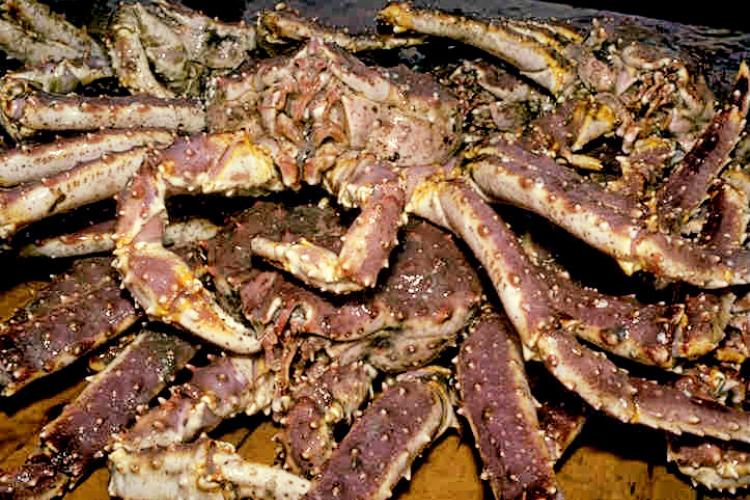Annual Crab Survey and Assessment
Each year we conduct a bottom trawl survey to assess the distribution and abundance of commercially important crab resources in the eastern Bering Sea. Periodic surveys are also conducted in the northern Bering Sea and Chukchi Sea. We collect biological information including sexual maturity, disease prevalence, condition, and size. We also regularly collaborate with the commercial fishing industry to improve our survey methods to produce the best estimates we can. This information is used for various studies on crab growth and reproduction and to help us estimate crab population size to better predict how many crab will be available to support future fisheries.
Ten crab stocks are included in the Fishery Management Plan for Bering Sea/Aleutian Islands. King and Tanner Crabs that we are responsible for assessing include: 4 red king crabstocks (Bristol Bay, Pribilof Islands, Norton Sound and Adak), 2 blue king crab stocks (Pribilof Islands and St Matthew Island), 2 golden (or brown) king crabstocks (Aleutian Islands and Pribilof Islands), southern Tanner crab, and snow crab.
Our science is used by resource managers at the North Pacific Fishery Management Council to determine sustainable catch limits for crab each year.
Mariculture Research
Mariculture, ocean aquaculture, can be important to enhance fishery stocks or to provide economic opportunities in coastal fishing communities and has been highlighted by the NOAA Aquaculture Program as vital for the nation. Many Alaska king crab stocks declined in the 1980s without recovery even in the absence of fishing pressure. We conduct laboratory and field research on red king and blue king crab species to assess the feasibility of using hatchery raised juveniles to enhance local stocks. Mariculture of other crab and seaweed species has been identified as an important opportunity in coastal Alaska. We are providing culturing expertise and facilitating the collection of coastal oceanographic data to monitor seasonal environmental conditions in the nearshore areas of the Kodiak Archipelago to support this research.
Ocean Acidification
Coastal regions around Alaska are experiencing the most rapid and extensive onset of ocean acidification compared to anywhere else in the U.S. We conduct laboratory experiments at the Kodiak Seawater Laboratory to see how increases in ocean acidification affect commercial crab development and survival. We apply the results of those experiments to population and ecosystem models to predict how increased ocean acidification may affect commercial resources and coastal communities. To monitor what is currently happening in the ocean, we measure the ocean chemistry (pH levels) in the nearshore waters around Kodiak and also measure crab responses to ocean acidification in the eastern Bering Sea and Chukchi Sea.

Close up of Blue King Crab mouth.
Crab Recruitment and Habitat
We conduct biological and ecological research necessary to improve our understanding of what drives crab recruitment (i.e., growth and survival) to the adult stock and what habitat is important. Recruitment and important habitat (Essential Fish Habitat) availability are often driven by environmental conditions so we conduct laboratory and field research to better understand the effect a changing environment has on crab. We also track the distribution and movement of crab among habitats using satellite and other tags.
Crab Growth, Condition and Maturity Studies
We measure processes such as growth, condition, and reproductive potential and input these data into assessment models to estimate crab population size. In the lab we grow crabs from early larval stages to young juveniles in different environmental conditions to predict changes in the adult stock abundance. It is also important to estimate how many crab survive to the adult stage so we study fisheries catch, predation, and disease. Understanding reproductive potential is important so we know how successful adult females are at producing offspring and providing future year classes.
Crab Ecosystem Indicator Development
We are developing stock-specific ecosystem indicators for commercially important eastern Bering Sea crab species. The indicators provide detailed information and updates on the status of the ecosystem components for each crab stock. They also provide early signals that might warrant management intervention.
Each crab stock will have a set of spatially explicit indicators summarized in the form of a "report card," which will be updated annually with survey data.
Stock-specific report cards and general description of each ecosystem indicator will be included as part of future annual Stock Assessment and Fishery Evaluation Reports compiled by the North Pacific Fisheries Management Councils Crab Plan Team. The intent is to refine stock assessments and better estimate crab population trends.
Additional Resources
- Resource Assessment and Conservation Engineering Division
- Alaska Crab Stock Assessment and Fishery Evaluation Reports
- Alaska Fisheries Science Center Research Surveys
- Eastern Bering Sea Crab Distribution Data Map
- Bering Sea and Aleutian Islands Crab Fisheries Summary Report
- Bering Sea and Aleutian Islands Economic Status Reports for King and Tanner Crab Fisheries
- Dutch Harbor Snow and Tanner Crab Growth Study
- Sample Request Instructions for Alaska Groundfish and Shellfish Assessment Surveys
- 2016 Eastern Bering Sea Continental Shelf Bottom Trawl Survey
- 2017 Eastern Bering Sea Continental Shelf Bottom Trawl Survey

